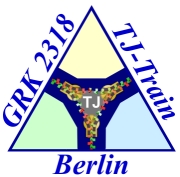
DFG Research Training Group "TJ-Train" (GRK 2318/2) Project C2
Priv.-Doz. Dr. Susanne M. Krug
Clinical Physiology
/ Nutritional Medicine, Campus Benjamin Franklin, Interaction of immune cells and TJ proteins in IBD
The tricellular TJ (tTJ) is considered to form a structural weak point of the barrier-forming TJ network and passage of antigens might be facilitated in this region in diseased states. Tricellulin, which is located at tTJs, plays a critical role for that as it is relevant for barrier formation against macromolecules and is affected in IBD. Hypothesis: We hypothetize that besides being involved in luminal antigen uptake, the tTJ and its components may be also important in immune cell translocation and activation. It has been described that neutrophils and other leukocytes prefer tricellular corners for their passage and expression of tricellulin, but also of other TJ proteins, has been observed in cells of the monocyte/macrophage lineage. Based on these findings, we suggest an immunoregulatory role of TJ proteins and direct interaction between immune cells and TJs, especially tTJs.Project: The doctoral thesis project we offer comprises characterizing the interaction of the (t)TJ barrier with subjacent immune-relevant cells and the mutual influence in developing IBD or inflammation in general. After isolating immune cells relevant for development and regulation of IBD and analyzing their potential expression profile of TJ proteins, direct interaction of the respective immune cells with their potential target TJ proteins will be visualized by live-cell confocal microscopy in cell lines expressing fluorescence-tagged TJ proteins. Interaction will be further characterized by higher resolved imaging techniques, by FRET (Förster resonance energy transfer), and by chemical coupling of the interacting partners and subsequent pulldown. The effect of immune response-activating substances will be analyzed to give insight into the regulation of tTJ permeability.2nd cohort PhD doctoral student Lena Voges
2nd cohort MD doctoral student 1st cohort PhD doctoral student Jia-Chen
E. Hu
Hu JCE, Bojarski C, Branchi F, Fromm M, Krug SM (2020) Leptin downregulates angulin-1 in active Crohn's disease via STAT3. Int. J. Mol. Sci. 21(21): 7824 (17 pages) [PubMed] [WebPage] [PDF] [Supplement] (IF 5.9) Project-related publications
Conrad MP*, Piontek J* (*shared first authorship), Günzel D, Fromm M, Krug SM (2016) Molecular basis of claudin-17 anion selectivity. Cell. Mol. Life Sci. 73(1): 185-200 [PubMed] [WebPage] [PDF] [Supplement] Demehri FR*, Krug SM* (*shared first authorship), Feng Y, Lee IM, Schulzke JD, Teitelbaum DH (2016) Tight junction ultrastructure alterations in a mouse model of enteral nutrient deprivation. Dig. Dis. Sci. 61(6): 1524-1533 [PubMed] [WebPage] [PDF] Yang S*, Krug SM* (*shared first authorship), Heitmann J, Hu L, Reinhold AK, Sauer S, Bosten J, Sommer C, Fromm M, Brack A*, Rittner HL* (*shared last authorship) (2016) Analgesic drug delivery via recombinant tissue plasminogen activator and mRNA-183-triggered opening of the blood-nerve barrier. Biomaterials 82: 20-33 [PubMed] [WebPage] [PDF] [Supplement] Richter JF, Schmauder R, Krug SM, Gebert A, Schumann M (2016) A novel method for imaging sites of paracellular passage of macromolecules in epithelial sheets. J. Contr. Release 229: 70-79 [PubMed] [WebPage] [PDF] [Supplement] [Movie S1] [Movie S2] Krug SM, Schulzke JD, Fromm M (2014) Tight junction, selective permeability, and related diseases. Semin. Cell Devel. Biol. 36: 166-176 [PubMed] [WebPage] [PDF] (Review) Krug SM, Amasheh M, Dittmann I, Christoffel I, Fromm M, Amasheh S (2013) Sodium caprate as an enhancer of macromolecule permeation across tricellular tight junctions of intestinal cells. Biomaterials 34(1): 275-282 [PubMed] [WebPage] [PDF] Westphal JK, Dörfel MJ, Krug SM, Cording JD, Piontek J, Blasig IE, Tauber R, Fromm M, Huber O (2010) Tricellulin forms homomeric and heteromeric tight junctional complexes. Cell. Mol. Life Sci. 67(12): 2057-2068 [PubMed] [WebPage] [PDF] [Supplement] Krug SM, Amasheh S, Richter JF, Milatz S, Günzel D, Westphal JK, Huber O, Schulzke JD, Fromm M (2009) Tricellulin forms a barrier to macromolecules in tricellular tight junctions without affecting ion permeability. Mol. Biol. Cell 20: 3713-3724 [PubMed] [WebPage] [PDF] [Supplement text] [Supplement video] Krug SM, Fromm M, Günzel D (2009) Two-path impedance spectroscopy for measuring paracellular and transcellular epithelial resistance. Biophys. J. 97(8): 2202-2211 [PubMed] [WebPage] [PDF] [Supplement] |